Today (March 6, 2024), the Australian Bureau of Statistics released the latest - Australian National…
Australian national accounts – second quarter of strong growth but still below where economy was a year ago
Coming off a low base. That is how to view the latest data release from the Australian Bureau of Statistics of the – Australian National Accounts: National Income, Expenditure and Product, December 2020 (released March 3, 2020). It shows that the Australian economy grew by 3.1 per cent in the December-quarter after growing by 3.4 per cent in the September-quarter. But the economy is still 1.1 per cent smaller than it was this time last year. The other thing to take from the data is that it once again confirms that nations that took the virus elimination strategy have done the best in economic terms compared to those nation which resisted tight lockdowns and other restrictions and are still enduring high infection rates and stalled economies. Household Consumption expenditure rose strongly as opportunities to spend increased and disposable income recovered somewhat. How long this considerable rebound can continue is another question. With the government fiscal support due to end soon and the base now higher, the coming quarters will not be as robust. And remember that the economy is still 1.1 per cent smaller and the labour market is still struggling and the Government’s fiscal support will still be required in certain sectors, which are still unable to achieve recovery (arts, tourism).
The main features of the National Accounts release for the December-quarter 2020 were (seasonally adjusted):
- Real GDP increased by 3.1 per cent for the quarter. The annual growth rate was minus 1.1 per cent
- Australia’s Terms of Trade (seasonally adjusted) rose by 4.7 per cent in the quarter and was up by a strong 7.4 per cent over the 12 month period. This is due to higher export prices for our primary commodities.
- Real net national disposable income, which is a broader measure of change in national economic well-being rose by 4.9 per cent for the quarter and was 2.1 per cent higher over the 12 months, which means that Australians are better off (on average) than they were at that point 12 months ago. A lot of that is due to the terms of trade effect.
- The Household saving ratio (from disposable income) decreased from 18.7 per cent to 12 per cent as the uncertainty over employment and health reduced and household spending resumed.
Overall growth picture – the recovery continues
The ABS – Press Release – said that:
The economy has continued to recover with activity increasing 3.1 per cent in the December quarter following the 3.4 per cent rise in September quarter. However, despite the two consecutive quarters of strong growth, economic activity remained 1.1 per cent lower than recorded in the 2019 December quarter …
This is the first time in the over sixty year history of the National Accounts that GDP has grown by more than 3.0 per cent in two consecutive quarters …
Household spending increased 4.3 per cent as COVID-19 restrictions continued to ease. Victoria recorded the strongest increase in household spending after strict lockdown restrictions were lifted.
The first graph shows the quarterly growth over the last five years (with the red line being the ABS moving average trend). The ABS has now stopped publishing the trend for the time being given the large swings in performance that will be experienced over the next several quarters.
The massive 2020 outlier renders graphs like this rather binary and suppress the variations in the growth performance in prior quarters.
To put this into historical context, the next graph shows the decade average annual real GDP growth rate since the 1960s (the horizontal red line is the average for the entire period (3.2 per cent) from the December-quarter 1960 to the December-quarter 2020).
The 2020-to-now average is obviously just the March- to December-quarter 2020 average.
I put the data labels in the graph because it is harder to differentiate the decades given the flattening effect of the current outlier.
It is obvious then how far below historical trends the growth performance of the last 2 decades have been as the fiscal surplus obsession has intensified on both sides of politics.
Even with a massive household credit binge and a once-in-a-hundred-years mining boom that was pushed by stratospheric movements in our terms of trade, our real GDP growth has declined substantially below the long-term performance.
Analysis of Expenditure Components
The following graph shows the quarterly percentage growth for the major expenditure components in real terms for the September-quarter 2020 (grey bars) and the December-quarter 2020 (blue bars).
Points to note:
1. The pre-Pandemic growth performance was already weak.
2. Household Consumption expenditure rose by 4.3 per cent in the December-quarter. Over the last 12 months, it has fallen by 2.7 per cent.
3. General government consumption expenditure rose by 0.8 per cent in the December-quarter and by 7.4 per cent over the 12 months.
4. Private investment expenditure growth rose (surprisingly) by 3.9 per cent for the quarter but was 1.7 per cent lower over the year.
5. Public investment rose by 2.5 per cent for the quarter and by 1.8 per cent for the year.
6. Export expenditure rose by 3.9 per cent in the December-quarter but fell by 11.7 per cent over the 12 months. Imports rose by 4.9 per cent for the quarter but were 9.6 per cent lower over the year.
Contributions to growth
What components of expenditure added to and subtracted from the 7 per cent decline in real GDP growth in the December-quarter 2020?
The following bar graph shows the contributions to real GDP growth (in percentage points) for the main expenditure categories. It compares the December-quarter 2020 contributions (blue bars) with the September-quarter 2020 (gray bars).
In order of contribution:
1. Household consumption expenditure contributed 2.3 points to the overall growth decline result as households starting spending more.
2. Private investment expenditure contributed 0.7 point to growth.
3. Growth in inventories were a contractionary force by 0.1 points. This is related to spending rising quickly and firms exhausting stocks.
4. Public consumption contributed 0.2 points and public investment 0.1 points. Overall, the government sector contributed 0.3 points.
5. Net exports reduced growth by 0.1 points – because the contribution of exports (0.8 points) was offset by the import effect (-0.9 points) (remember imports are a drain on expenditure).
Material living standards rose significantly in December-quarter 2020
The ABS tell us that:
A broader measure of change in national economic well-being is Real net national disposable income. This measure adjusts the volume measure of GDP for the Terms of trade effect, Real net incomes from overseas and Consumption of fixed capital.
While real GDP growth (that is, total output produced in volume terms) rose by 3.1 per cent in the December-quarter 2020, real net national disposable income growth rose by 4.9 per cent.
How do we explain that?
There was a rise in employee compensation (of 1.5 per cent), which boosted household disposable income.
Further the terms of trade improved quite sharply.
The following graph shows the evolution of the quarterly growth rates for the two series since the December-quarter 2006.
Household saving ratio falls from 18.7 to 12 per cent as household spending returns
As more opportunities to spend opened up with the pandemic restrictions being relaxed, household consumption expenditure improved.
The following graph shows the household saving ratio (% of disposable income) from the December-quarter 2000 to the current period. It shows the period leading up to the GFC, where the credit binge was in full swing and the saving ratio was negative to the rise during the GFC and then the most recent rise.
While the saving ratio might appear to be still very high, if we take a longer term view of it, the behaviour is less ‘historic’ than we might think. Back in the full employment days, when governments supported the economy and jobs with continuous fiscal deficits (mostly), households saved significant proportions of their income.
In the neoliberal period, as credit has been rammed down their throats, the saving rate dropped (to negative levels in the lead-up to the GFC).
Hopefully, households are paying off the record levels of debt they are now carrying and improving their financial viability.
To put the more recent period into an historical context, the next graph shows the household saving ratio (% of disposable income) from the December-quarter 1960 to the current period.
The following table shows the impact of the neoliberal era on household saving. These patterns are replicated around the world and expose our economies to the threat of financial crises much more than in pre-neoliberal decades.
The result for the current decade (2020-) is the average for the March to December observations.
| Decade | Average Household Saving Ratio (% of disposable income) |
| 1960s | 14.3 |
| 1970s | 16.1 |
| 1980s | 12.0 |
| 1990s | 5.4 |
| 2000s | 2.2 |
| 2010s | 6.42 |
| 2020- | 15.2 |
Real GDP growth and hours worked
The following graph presents quarterly growth rates in real GDP and hours worked using the National Accounts data for the last five years to the December-quarter 2020.
The December-quarter data shows the rather dramatic reversal in total hours worked with real GDP following.
To see the above graph from a different perspective, the next graph shows the annual growth in GDP per hour worked (labour productivity) from the December-quarter 2008 quarter to the December-quarter 2020. The horizontal red line is the average annual growth since December-quarter 2008 (1.1 per cent), which itself is an understated measure of the long-term trend growth of around 1.5 per cent per annum.
The relatively strong growth in labour productivity in 2012 and the mostly above average growth in 2013 and 2014 helps explain why employment growth was lagging given the real GDP growth. Growth in labour productivity means that for each output level less labour is required.
The distribution of national income slight recovery in the wage share
The wage share in national income grew marginally by 1.9 points to 50.9 per cent – coming off a record low of 49 per cent.
This is why we say off a low base.
The first graph shows the wage share in national income while the second shows the profit share.
The declining share of wages historically is a product of neoliberalism and will ultimately have to be reversed if Australia is to enjoy sustainable rises in standards of living without record levels of household debt being relied on for consumption growth.
The change in final demand at the State/Territory level
The following graph shows the percentage decline in final demand for the States and Territories for the December-quarter. It is taken from the ABS Table (thanks).
It is clear that the end of Victoria’s harsh Stage 4 lockdown which has eliminated the virus there has led to a rapid recovery in state final demand and household expenditure.
Conclusion
Remember that the National Accounts data is three months old – a rear-vision view – of what has passed and to use it to predict future trends is not straightforward.
The recovery in real GDP growth in the December-quarter is welcome and shows the advantages of eliminating the virus and allowing the economy to reopen after the harsh lockdowns.
But the economy is still 1.1 per cent smaller and the labour market is still struggling and the Government’s fiscal support will still be required in certain sectors, which are still unable to achieve recovery (arts, tourism).
That is enough for today!
(c) Copyright 2021 William Mitchell. All Rights Reserved.

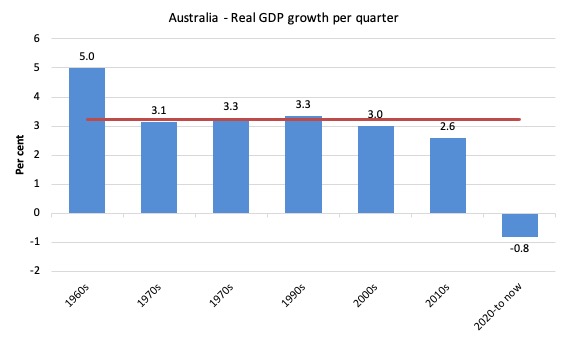
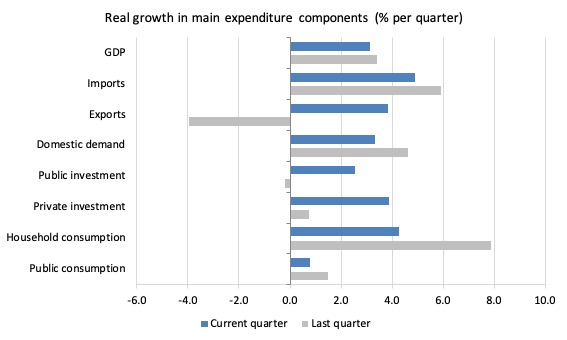
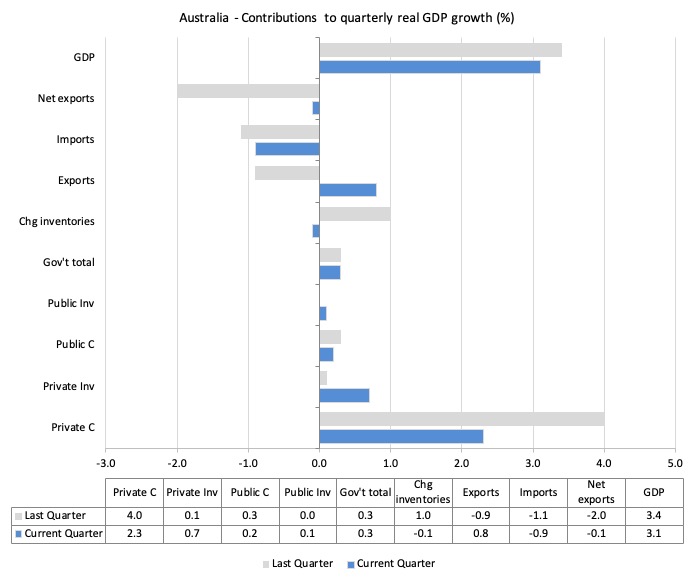
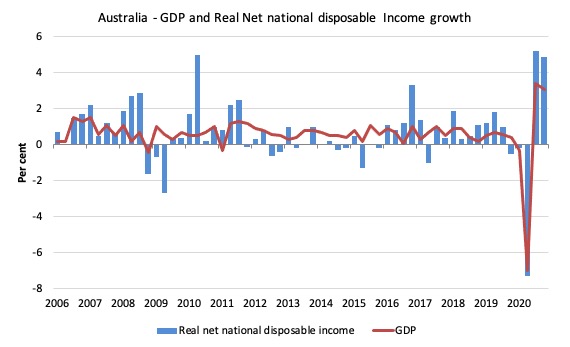
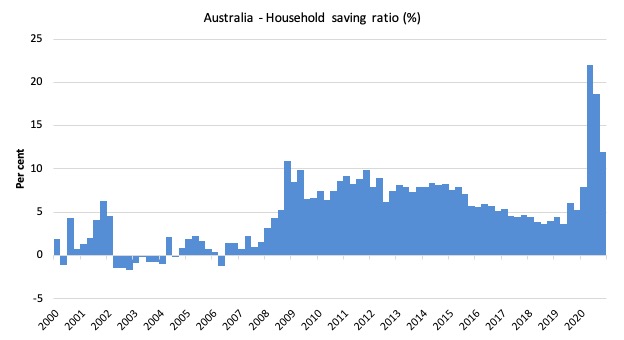
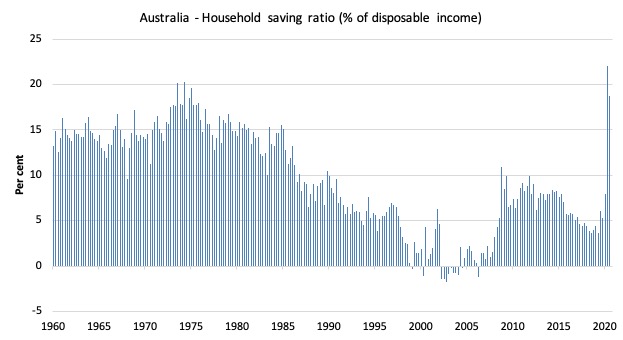
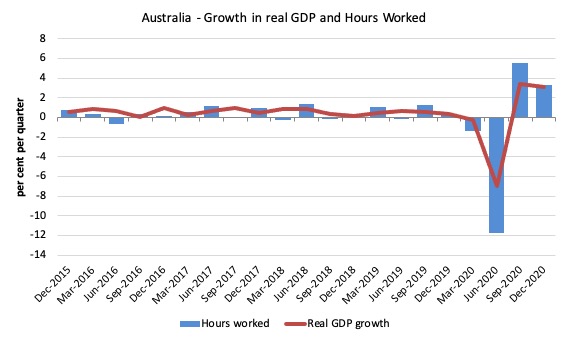
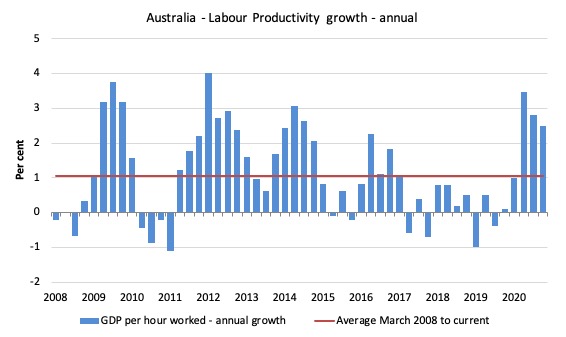
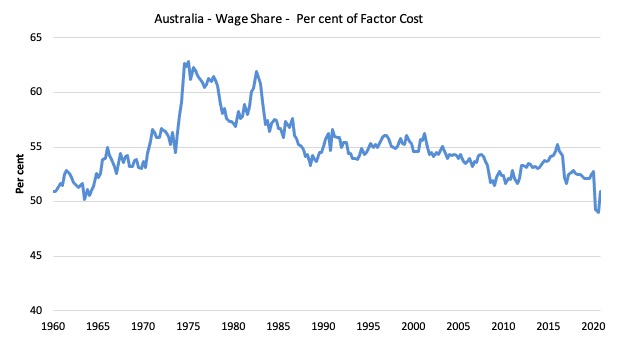
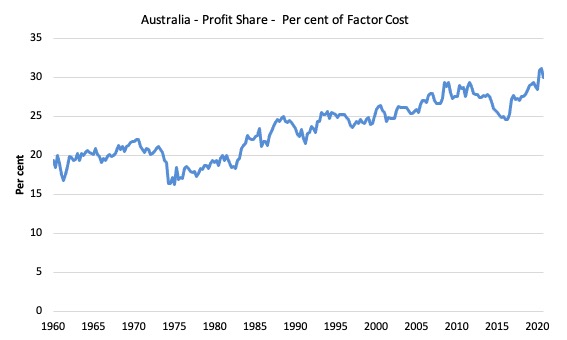
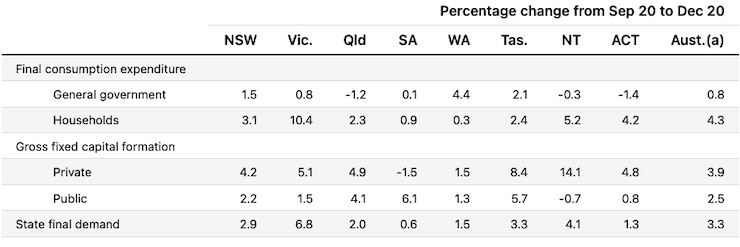
It’s Wednesday today isn’t it? Bill, I for one missed having my musical experiences widened as well as continuing my economics education. Looking forward to next Wednesday already, or maybe this signals a change for the blog. Hope you are not too busy and I’m not pre-empting something but can I perhaps step in with a link to something uplifting (Dreamland) from Bunny Wailer who died yesterday: https://www.youtube.com/watch?v=1jfoScCnjRY